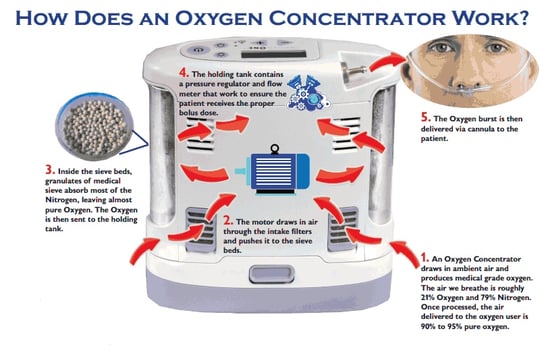
For today's oxygen therapy patients, requiring treatment for their medical conditions is often stressful enough.
But with that stress, they also become more and more adamant about maintaining active, independent lifestyles.
It's difficult if they have to use the antiquated, cumbersome oxygen tanks that restrict their movements.
It's time to move to better solutions that enable them to live their lives to the fullest with one of the most recent devices.
Types of oxygen concentrators
There are two types of oxygen concentrators: home and portable. As the name suggests, the home devices use the electricity supply available from the patient's home.
It simply plugs into a wall socket.
Home concentrators are designed to be mobile throughout the patient's home, so it is required to be heavier -- many models average from 30-53 pounds -- and are supplied with casters for easy from room to room maneuverability. It can even move outdoors if it has a longer tube supply.
The most popular home concentrator is the Respironics EverFloQ due to its lighter weight (31 pounds) and it being one of the quietest home units.
Portable concentrators also plug into wall sockets, but their usage goes beyond that.
Extremely lightweight, they can also be plugged into car 12V D/C cigarette lighters or operate through the use of a lithium-ion battery.
Not to mention, most portable oxygen concentrators are FAA approved and can be brought trains, buses, and cruise ships.
How do oxygen concentrators work?
An oxygen concentrator works very much like an air conditioning unit. Air goes in, is modified, and delivered back in the new form.
Oxygen concentrators produce medical grade oxygen on their own. Their process for doing so works in this manner:
- They pull in the surrounding room air and filter it.
- The oxygen then undergoes a filtration process, and is compressed.
- From there, the flow moves through two or more chambers that are filled with a material that removes the nitrogen from the air via a filter and sieve beds.
- The medical grade oxygen is then sent through a flowmeter through a nasal cannula or a mask.
How the oxygen is delivered?
The newly formed oxygen is delivered through a steady supply as long as the oxygen machine is plugged in to a permanent wall electrical source.
The cannula is a device that fits under the nostrils. It's normally supported by loops formed around the ears.
Any time there is breathing oxygen through a cannula, the patient also breathes in surrounding air. This in turn mixes with and dilutes the oxygen.
The oxygen masks come in numerous shapes and sizes. They always cover the mouth and nostrils.
The air delivered through a mask is somewhat more concentrated than that of a cannula. It should also be noted that the cannula is much more comfortable to wear than a mask.
Trousbleshooting issues with oxygen concentrators
Every oxygen concentrator provides visual and audio alarms to notify the patient if something is not right with the device. These include:
- Power failure
- High and low pressure alarms
The patient should be aware that if the outlet pressure drops below a certain level or gets too high, there may be an internal problem that requires maintenance.
If this is the case, it could be something as simple as a clogged filter or complex as internal valves or the compressor.
Patients should contact their dealer where they purchased the oxygen machine for assistance.




